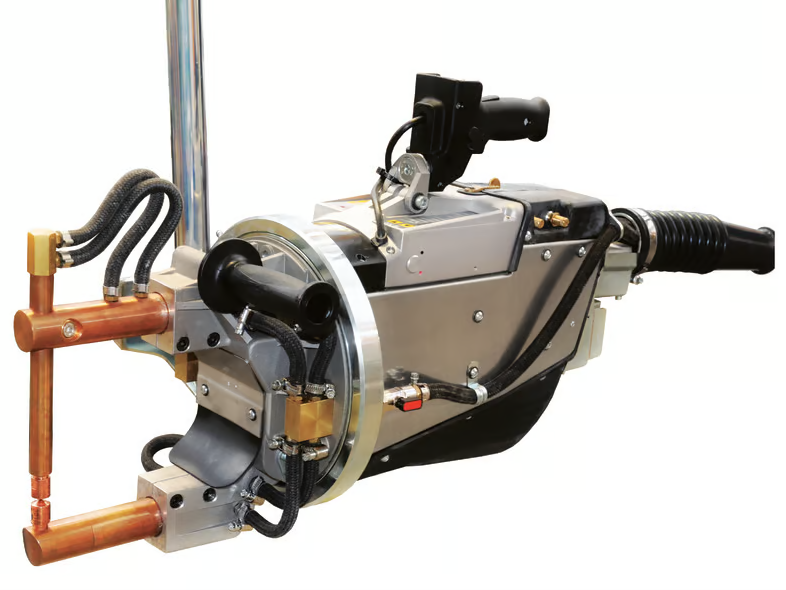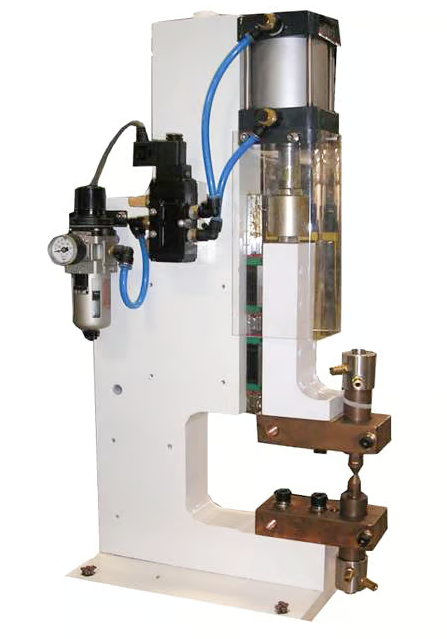Spot welders, with their origins tracing back to the early 20th century, have revolutionized the way industries join metal sheets. These machines, pivotal in the development of manufacturing processes, particularly in the automotive and aerospace industries, utilize high-precision electrical currents to generate heat and create robust welds. This brief history underscores their importance in industrial advancements and the ongoing innovation in welding technology, making them a crucial tool for modern fabrication needs.
Popular Types of Spot Welders
Spot welders come in various styles, each suited to specific applications and materials. Portable spot welders offer flexibility for small-scale or on-site projects. Pedestal spot welders, designed for industrial use, provide higher power and stability for consistent welds. Handheld spot welders are user-friendly and ideal for quick repairs or limited space. Benchtop models balance power and size, suitable for workshops. Each type caters to different needs, from DIY projects to professional manufacturing, ensuring precise and reliable spot welding across diverse materials. Among the various types available, three stand out for their specific applications and benefits:
Press Type Spot Welders
Press Type Spot Welders are known for their robust design and high-efficiency welding capabilities. These machines utilize a vertical pressure mechanism, which ensures uniform and precise application of force across the welding area. This consistency is crucial for achieving high-quality welds, especially in industrial settings where repeatability and durability are paramount. Press Type Spot Welders are typically employed in applications requiring deep throat depths and higher force, making them ideal for working with thicker materials or larger components. Their design allows for a wide range of adjustments in terms of pressure and current, providing the flexibility needed to weld various types of metals with precision.
Rocker Arm Welders
Rocker Arm Welders distinguish themselves with a pivoting arm mechanism that offers versatility and ease of use, particularly for workpieces of varying sizes and shapes. The rocker arm facilitates the welding of items that may not fit into more conventional, fixed welding setups, making these machines a popular choice for custom or irregularly shaped projects. The arm’s swinging motion allows for quick and easy alignment of the welding electrodes to the workpiece, enhancing productivity and reducing setup time. Rocker Arm Welders are well-suited for light to medium gauge materials, and their relatively simple design makes them a cost-effective solution for many welding tasks.
Spot and Projection Combination Welders
Spot and Projection Combination Welders represent a versatile and powerful class of welding equipment, capable of performing both spot and projection welding tasks. This dual functionality makes them highly valuable in settings where both types of welding are frequently required, eliminating the need for multiple machines. Projection welding, a variation of spot welding, involves the use of raised sections (projections) on one or more workpieces to concentrate welding current, allowing for multiple welds to be made simultaneously or thicker materials to be joined. These combination welders offer great flexibility, allowing operators to switch between spot and projection welding as needed, thus optimizing workflow and productivity. They are particularly useful in automotive, electronics, and appliance manufacturing, where precision and efficiency are critical.
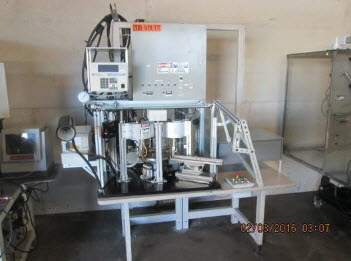
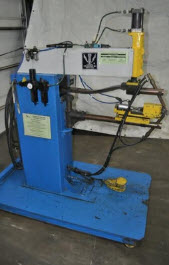
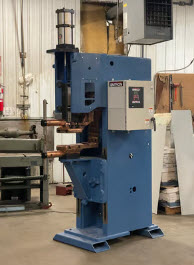
Getting started with spot welding
Spot welding is a foundational technique in metal fabrication, enabling the joining of metal pieces with precision and strength. As you begin spot welding, understanding the essentials—from the equipment required to the process nuances—is vital. This section delves into the key aspects to get you started, ensuring a solid foundation for your welding projects.
What do I need to spot weld?
To start spot welding, you need a reliable spot welding machine, suitable electrodes for the metal types you plan to weld, protective gear (such as gloves and eye protection), and the metal pieces you intend to join. Preparation is key, so ensure the surfaces to be welded are clean and properly aligned for optimal results.
How many amps does a spot welder use?
The electrical current required for spot welding varies significantly, typically ranging from several hundred to a few thousand amps. This depends on the welder’s capability and the thickness and type of materials being welded. Selecting the correct amperage is crucial for creating strong, reliable welds without damaging the material.
How long does it take to spot weld?
Spot welding is a quick process, generally taking only a few seconds per weld. However, the exact duration can vary based on the material’s thickness, the welder’s settings, and the desired weld strength. Properly calibrated equipment and experienced operators can achieve efficient and high-quality welds in minimal time.
What is the best spot welding machine?
The ideal spot welding machine depends on your specific requirements, such as the types of metals you’re working with, the volume of work, and the precision needed. High-quality machines offer adjustable welding parameters, durable construction, and user-friendly interfaces. Researching brands with strong reputations and seeking machines that provide consistency and control will lead you to the best choice for your welding tasks.
What is the difference between spot welding and arc welding?
Arc welding and spot welding are distinct in their applications and processes. Arc welding involves creating an electric arc between an electrode and the base material to melt metals at the welding point, suitable for a wide range of constructions and repairs. Spot welding, on the other hand, uses electrode pressure and electrical current to weld overlapping metal sheets, primarily used in fabricating sheet metal products. The key difference lies in their techniques and applications, with arc welding providing versatility for various materials and spot welding offering efficiency for thin materials.
What are the 3 stages of spot welding?
The process of spot welding can be divided into three primary stages:
- Electrode Pressure Application: This initial stage is critical for establishing firm contact between the metal sheets. The pressure applied by the electrodes must be sufficient to ensure a tight fit, which is crucial for the effectiveness of the weld. This step also aligns the materials to ensure the current passes uniformly.
- Heat Generation: The core of the spot welding process, where the electric current’s intensity and duration are meticulously controlled. The resistance at the contact points generates heat, melting the metals locally. The skill lies in adjusting the current to create the ideal heat amount—enough to meld the materials without causing excessive warping or damage.
- Cooling and Solidification: After the current is stopped, the pressure is maintained while the molten spot cools and solidifies. This cooling phase under pressure is vital to forming a strong bond. Rapid cooling can lead to brittleness, whereas too slow a cooling rate may weaken the weld’s integrity.
Understanding these stages in detail allows for optimizing the spot welding process, ensuring robust and durable welds suitable for various applications.
What can you use a spot welder for?
Spot welders are incredibly versatile tools that cater to a wide range of materials, each with its unique considerations:
Can you spot weld stainless steel?
Absolutely. Stainless steel is a prime candidate for spot welding due to its resistance to corrosion and strength. The key to successful welding lies in managing the heat effectively to prevent warping or compromising the material’s structural integrity. Proper electrode selection and calibration are essential to achieve clean, strong welds.
Can you spot weld aluminum sheet?
Spot welding aluminum is indeed possible but presents challenges due to its high thermal conductivity and the presence of an oxide layer that can inhibit welding. Specialized electrodes and precise control over welding parameters are necessary to penetrate the oxide layer and ensure a strong weld. Despite these challenges, with the correct setup, spot welding can be a quick and efficient method for joining aluminum sheets.
Can you spot weld copper?
Copper can be spot welded, though it requires considerable energy due to its high electrical and thermal conductivity. The process may demand specific welding technologies and careful parameter adjustments to achieve effective and reliable welds. Copper’s conductivity means that higher currents and specialized electrodes might be necessary to concentrate the heat and create a solid weld without excessive energy waste.
In each case, understanding the material properties and adjusting the welding parameters accordingly are crucial for successful spot welding. This adaptability makes spot welding a valuable process for a variety of applications in manufacturing, repair, and fabrication settings.
Can I use a TIG welder as a spot welder?
While TIG welders are primarily designed for continuous welding, with the right technique and settings, they can be adapted for spot welding tasks. This involves using a TIG welder to make quick, localized welds similar to those created by a dedicated spot welder. The key is in controlling the welder’s amperage, pulse settings, and duration of the arc to simulate a spot weld. This method requires practice and precision to achieve the desired outcome, making it a versatile option for those skilled in TIG welding.
How strong is spot welding?
Spot welding is renowned for producing strong and durable welds, particularly when joining sheet metals. The strength of a spot weld depends on the materials being welded, the thickness of those materials, and the welding parameters used. Properly executed spot welds create a bond that often matches or exceeds the strength of the surrounding material, ensuring the structural integrity of the welded assembly. This makes spot welding a reliable method for applications requiring high strength and durability, such as in automotive bodywork or metal furniture manufacturing.
The dangers of DIY spot welding
DIY spot welding requires not only technical skill but also a deep understanding of safety protocols. The primary risks include:
- Electrical Hazards: Improper handling or equipment malfunction can lead to electric shocks, which are dangerous and potentially fatal.
- Burns and Fire Risks: The intense heat generated can cause severe burns to skin and ignite flammable materials nearby.
- Eye Damage: The bright arc light can result in “arc eye” or flash burns without proper eye protection.
- Toxic Fumes: Welding certain materials can release hazardous fumes, necessitating adequate ventilation.
- Weak Structural Integrity: Without precise control and understanding, welds may be weak, risking the failure of the welded structure under stress.
It’s essential to prioritize learning, use the correct safety gear, and understand the limitations and risks of DIY spot welding to mitigate these dangers effectively.
As we’ve explored the intricacies of spot welding, from its applications to the nuances of DIY approaches, it’s clear that having the right equipment is crucial for success. Whether you’re a hobbyist or a professional, Surplus Record offers a vast selection of spot welders to suit your specific needs. Find the perfect match for your project, and start welding with confidence. Visit Surplus Record to explore our inventory and take the next step in your welding journey.

